Growing Food for Taste and Flavor
Posted on Thursday, January 12, 2023 · Leave a Comment
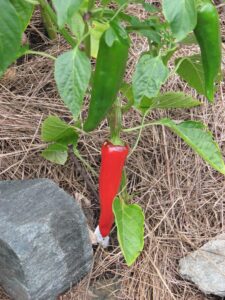
My favorite pepper is the Espelette, a hot pepper I first tasted in France
We gardeners love our home grown vegetables. As John Denver sang long ago, “Only two things that money can’t buy and that’s true love and homegrown tomatoes.” And why do they taste so good? We can grow tomatoes that don’t have to conform to commercial requirements of size, shape, color and transportability. Our soils generally are rich in compost or manure and host a wide range of minerals and micro-organisms that enhance the flavors of our vegetables. And of course, we eat them fresh from the garden.
We can taste five flavors: sweet, sour, salty, bitter and umami. These flavors were important to our evolution as they told early humans what was safe to eat – and what to avoid. The fifth flavor was not named until the last century: umami signals available protein in meat, eggs, milk, and beans. It is not as easily described or identified as the other four, but it is sometimes described as the flavor of contentment. We need protein, and feel good when we eat it.
So how can we recognize the complex flavors of a good stew, and aged cheese or a bowl of exquisite ice cream? Our noses can recognize many thousands of distinct scents, and our noses and tongues work together to create tastes. Good chefs recognize this, and many farmers do, too. I recently read a book that contains interviews with fine organic farmers who treasure their soil and what it imparts to the scents and flavors of the food they grow.
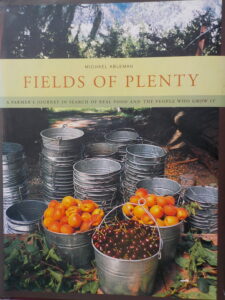
This book recounts a wonderful journey across America visiting organic farmers
That book by Michael Abelman is called “Fields of Plenty: A Farmer’s Journey in Search of Real Food and the People Who Grow It”. Abelman, an experienced author and organic farmer in British Columbia, spent three months traveling around the States in a 15-year old VW van. He went with his 23-year old son back in 2004. They camped out, ate local food and met with organic farmers, some of whom were growing food for the best restaurants in America.
There is much to love about this book: Abelman is a skilled writer and story teller, he is a talented photographer, and he is adventurous and inquisitive. Not only that, he included recipes from many of the farmers, and they all sound delicious – and mostly vegetarian.
Each of these farmers he wrote about had a unique approach to farming. One let weeds grow rampant. Another had fields that were weed free and managed with “precision, control, formal science and discovery.” But all ate their own food, fresh from the field – or in the field. And each interview gave me something to think about, and perhaps to apply to my garden.
One of the most startling interviews was with Bob Cannard in Sonoma, California. Raised on a farm, Bob went to agriculture school but dropped out and started his own farm. When starting out, Bob grappled with this question: Why are natural places naturally healthy, while the fields and orchards of commercial agriculture are a continual battleground with weeds, insects and diseases?
His approach to farming was to try to mimic nature – weeds and all. He believed that plants that struggle to survive would develop more complex flavors – a belief later adopted by some wine makers. He believed that a monoculture – acres of the same crop – encouraged insect pests to arrive and necessitate insecticides. He succeeded as a farmer, selling vegetables to Chez Panisse and other high-end restaurants in San Francisco.
I was fascinated to read the section on Strafford Organic Creamery in Vermont. Earl Ransom has a small herd of Guernsey cows and bottles their milk in glass bottles and makes fabulous ice cream, which I know and love. Ransom believes that he gets wonderful flavors by letting his cows graze in pastures with a variety of grasses, wildflowers and weeds. Diversity in the field creates better milk, he says, and the fat in milk absorbs flavor.
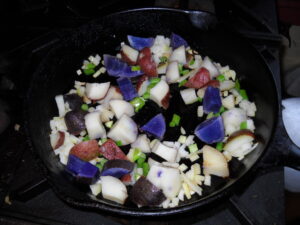
I grow and eat potatoes of several colors
The book provides the names of many varieties of vegetables that are exceptional. Organic farmers Gene and Eileen Thiel of Joseph, Oregon specialize in potatoes, and particularly likes LaRatte, Yagana and Sante. Sante, he said, is like a Yukon Gold, but bigger. Yukon Gold also got high marks, as did Ranger Russets and Yellow Finn. He avoids losing his crop to blights, in part, by growing lots of different kinds of potatoes – as did the Incas, where potatoes came from. Of course there is no guarantee that a potato that does well in Oregon will do well for you.
Abelman, a farmer for decades mentions some of his own favorite vegetable varieties. For sweet peppers he likes Ariane, Red Lipstick (I want to grow it, if just for that name) and Corno di Toro. Then there is the Charentais melon, about which he waxes poetic.
Of beans, some of the varieties mentioned as excellent include Valentine and Sophia flageolet shell beans, Maine Yellow Eye, Vermont Cranberry and Red Streaked Borllotto. According to the book, thin-skinned dry beans are easier on the digestive system: “the skins harbor the chemistry that causes digestive problems.”
It’s time for all of us to be studying seed catalogs and seed websites to pick the vegetables we’ll grow this year. I’ll be referring to Abelman’s book for new varieties, but also going back to my old favorites.
Henry is a lifelong organic gardener and the author of four gardening books. Reach him by e-mail at
henry.homeyer@comcast.net or by regular mail at PO Box 364, Cornish Flat, NH 03746.
Why Eating Organic Food Is Important
Posted on Tuesday, January 19, 2021 · Leave a Comment
I’ve been growing vegetables organically all my life. I use no chemical fertilizers or pesticides. I don’t often think about the reasons I do so, any more than I think about breathing – it’s just something I do.
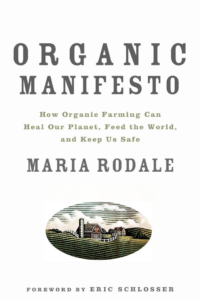
Organic Manifesto
I recently picked up a book written by Maria Rodale called The Organic Manifesto: How Organic Farming Can Heal Our Planet, Feed the World, and Keep Us Safe (Rodale Press, 2010) and it reminded me why I do so. I’d like to share some of the important points with you here.
In the introduction Eric Schlosser (author of the fabulous book, Fast Food Nation) presented some stark facts: American farmers use 1.2 billion pounds of pesticides each year – 4 pounds for every man, woman and child. Some of these pesticides – the organophosphates – were first developed in Germany in WWII as chemical weapons. The federal government does not require reporting of usage, and testing is done by manufacturers, not the EPA or USDA. Most food has some pesticide residue – except for organic foods,which shouldn’t have any.
One of Maria Rodale’s reasons for eating only organic food might surprise you: it has to do with climate change. Soils treated with chemicals, including fertilizers, do not have robust populations of microorganisms. Organic soils do. Key among these living beings are the mycorrhizal fungi that coat the roots of plants in organically tended soils. These fungi sequester huge amounts of carbon, taking greenhouse gases out of the atmosphere and holding it the soil. But they are virtually non-existent in soils treated with chemicals. Grow organically? Eat organically? You are helping the environment.

My organic veggies look and taste great
Secondly, irrigation water for commercial agriculture, particularly in the West, uses large quantities of water, depleting aquifers and polluting ground water. When I traveled through the mid-west in the early 2000’s I was amazed that supermarkets designated entire aisles to jugs of water – no one wanted to drink from their own wells. And there is a dead zone in the Gulf of Mexico that is bigger than New Jersey caused by agricultural run-off of chemicals from conventional fields.
Children are particularly vulnerable to chemicals used in commercial farming. Rates of childhood cancers, asthma, diabetes, autism and other debilitating conditions continue to increase. Ms. Rodale attributes (with copious footnotes to scientific studies) many of these changes to the chemicals children consume. As she says, “Cheap food equals high health care costs.”
The “organic” label on food also means that no genetically modified organisms were used in producing your food. Back in 2010 when Rodale wrote the book, 91% of all soybeans and 95% of all corn produced in America was genetically modified to be tolerant of a weed killer called glyphosate, sold under the trade name, “Roundup”.

Organic fertilizers contain more healthy minerals than chemical fertilizers
There has been much controversy about Roundup, and whether it is harmful to humans. Ms. Rodale points out that Roundup cannot be washed off food: it has a surfactant that allows the chemical to penetrate the cell wall. And since corn and soy are used to manufacture many foods from ice cream to baby food and ketchup, it is everywhere. The federal government does not consider Roundup a problem, though many scientists do.
Ms Rodale never once, in this book, criticized conventional chemical farmers. Organic or conventional, she recognized their hard work and a desire to work their land and support their families. She recognizes that transitioning to organic farming takes time, money, and education.
So what can you do? You may not be able to afford to buy nothing but organic food. But you probably can buy your meats from local farmers that do not use the feedlots of the mid-West that feed their cows and pigs antibiotics. And you can get eggs, as I do, from a local teenager that treats his hens well. (Thank you, Ian’s Eggs).
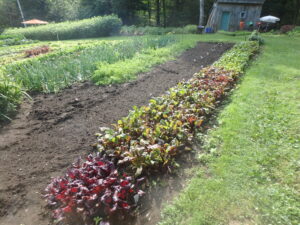
This organic farmer has nurtured soil rich in microorganisms that sequester carbon
For vegetables, you can probably grow some of what you require for vegetables in summer, or buy from a local farm stand. Many farmers are happy to tell you about how they grow their vegetables. The supplier of the local farm stand near me uses an approach called IPA or Integrated Pest Management. This method encourages farmers to use natural controls, and to use pesticides only when a crop is threatened. They cultivate crops to root out weeds instead of spraying herbicides like Roundup.
But the bottom line is this: the more you grow organically, the better your soil will be. If you use only organic methods, you can avoid many chemicals in your food that might be present in grocery store foods.
I recognize that I cannot change the world with what I do. But I have learned to grow plenty of vegetables, and to keep them for eating out-of-season. So think about a bigger vegetable garden this summer, and I will tell you about how to put food up for next winter when the time comes.
Henry is the author of 4 gardening books and a UNH Master Gardener. He lives in Cornish Flat, NH. You may reach him at
henry.homeyer@comcast.net.









